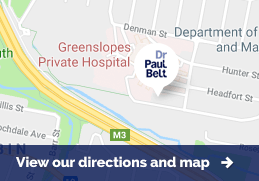The Procedure
Body lift is a combination of an abdominoplasty or “tummy tuck” as well as a back or “buttock lift”. A body lift is an operation that removes the circumferential excess skin around the belt area.
The amount of excess skin is carefully assessed and the exact amount of excess skin is removed as an excision encircling the entire body at the level of the waist i.e. a “belt lipectomy”.
This is usually required in patients with massive weight loss (40kg or 40% of body weight). In addition, the separation of the rectus abdominis muscles can also be re-tightened and corrected at the same time.
Furthermore, excess skin is taken to lift the ptosis (droop) which is caused by the massive amount of weight that is lost.
It is also possible to perform a buttock augmentation. This is followed by simply taking the skin off the excess tissue and by using a suture technique, the more deeply lying fat tissue can be shaped into a natural buttock shape. The skin above and below, the area of resection is then pulled tightly over the created mound to form a natural buttock shape.
This surgery results in an incision running the entire circumference of the abdomen at the level of the belt. The skin above and sometimes below this is undermined to allow greater re-draping.
The umbilicus does need to be repositioned in the same way with an abdominoplasty. Drains are then placed and the skin is sutured together using a combination of dissolvable sutures.
From 1st January 2016 Medicare has imposed restrictions on the use of the item number for Body Lift. In order to qualify under the new Medicare guidelines it is important that patients fulfil the following criteria:
- There is intertrigo (severe rashes and skin ulceration) or another skin condition that risks loss of skin integrity and has failed three months of conventional (non-surgical) treatment
- The excess skin interferes with the activities of daily living
- The weight loss is equivalent to a loss of 5 BMI (body mass index) points which has been stable for at least six months
Body lift With Buttock Augmentation
When patients have lost a considerable amount of weight, this can lead to a redundancy of excess skin on the posterior part of the torso.
The nature and pattern of the excess skin differs dramatically between individuals. It is possible to tailor an operation so that the precise areas of excess skin are removed. The exact pattern of the excision will differ between individuals. This is usually done as a horizontal excision of skin and fat. This operation can frequently be performed with an abdominoplasty or tummy tuck which will result in a circumferential scar running around the body. This is also known as the “Belt” lipectomy. Please note that this is a reference to the final scar that runs around the body like a belt, and is not related to my surname.
This will lead to an improvement in the contour and definition of the back as well as the upper part of the thigh.
The scar is generally concealed by the patient’s underwear.
It is also possible that a patient could have the fat under the skin sculptured in order to create a buttock mound and then the skin is re draped over the surface of the newly augmented buttock. This combination will produce a more defined gluteal or buttock prominence which will help to restore the contour. This is an area that is classically deficient in volume and lacks definition in patients who have lost a significant amount of weight.

Complications and Risks
All Procedures have potential complications and risks. These can be divided into general complications and those specific to each procedure. The latter are listed in the FAQs below.
General complications include:
- Wound complications - bleeding, bruising, collections under the skin of blood (haematoma), pus (abscess), serous fluid (seroma), infection, wound breakdown, suture extrusion, sensory loss;
- Aesthetic complications - poor scars, stretched scars, raised scars (keloid or hypertrophic), contour irregularities, need for revisional procedure;
- Anaesthetic complications
FAQs
-
Is it possible to combine a body lift with other procedures?
It is possible to perform a body lift with multiple other procedures. These may include breast surgery (augmentation, reduction and lift/mastopexy). The advantage of combining these procedures is that it leads to a complete transformation of the appearance of the anterior part of the torso. There may also be significant cost advantage to the patients by combining procedures.
-
What are the potential costs involved?
Dr Belt’s fee, an assistant’s fee, theatre fee, day bed and price of overnight accommodation, specialist anaesthetist fee and the cost of two support garments.
Our fees attract rebates from Medicare and Health Funds, please contact Dr Belt’s rooms for a specific quote.
-
What are the potential risks?
These can be broken down into those general risks for any procedure and those specific to the procedure.
Specific risks include asymmetry both in scars, umbilicus and the skin contour, loss of fat and skin (necrosis), wound breakdown, collections of fluid underneath the skin including serum (seroma), blood (haematoma), pus (abcess), damage to the deeper underlying intra abdominal organs and permanent numbness of the lower abdominal skin.
Smoking will significantly increase the risk of these complications as does obesity.
It is important that a patient’s health is maximised before surgery to minimise these risks. This includes ceasing smoking at least three months before the surgery. In addition, if one can obtain the ideal weight prior to surgery then the benefit of the operation is maximised. Subsequent alterations in body weight including gain and reduction may reduce the long terms effects of the abdominoplasty.
General risks include bruising, swelling, bleeding, wound infections, anaesthetic related problems and problems related to abnormal scarring (hypertrophic, keloid & stretched scar).
It is possible to perform liposuction to the flanks “love handle’ area as this area is not directly involved with the surgery and does not increase the operative risks.
-
What happens after the surgery?
This surgery is usually performed as an inpatient and patients can be expected to stay at least one night in hospital. Drains will be inserted into the wounds which exit below the wound through the midline of the abdomen just above the mons area or from the sides of the wounds. These may stay in for a number of days after surgery if the drainage is excessive.
Most patients have the drains removed 3-5 days after the surgery. You will be expected to wear a support garment around the abdomen for a period of six weeks. You will be seen daily whilst an inpatient then at regular intervals usually for a period of 12 months.
-
What type of anaesthetic is used?
Dr Belt will only perform this surgery under the control of a General Anaesthetic administered by a specialist anaesthetist.














